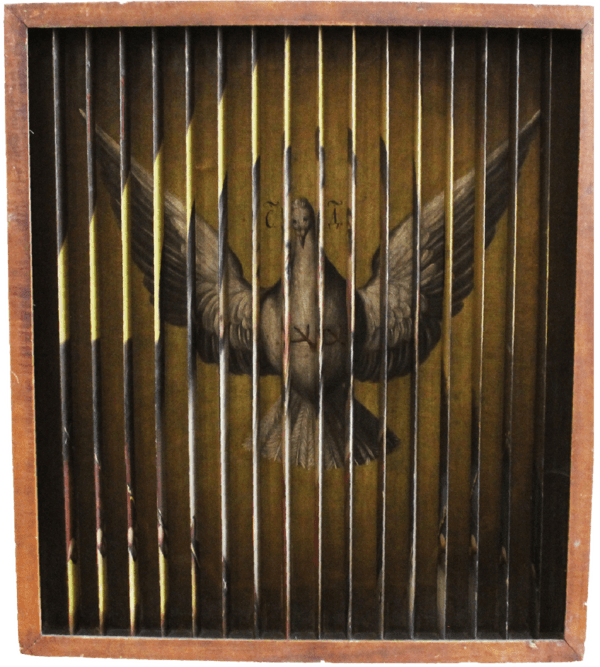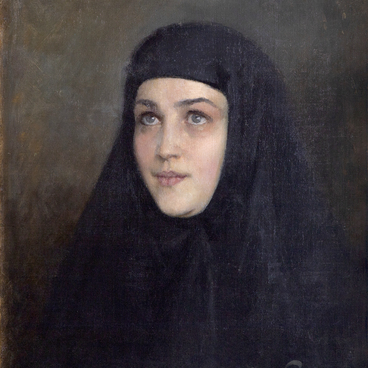Felipe Nunez described the secret of making a triscenorama in the 17th-century treatise “The Art of Poetry, Painting and Symmetry with the Principles of Perspective”, which was published in Lisbon in 1615. One of the chapters was called “How to Make a Panel with Three Figures, Each of Which Should be Seen Separately.”
This technique was used to create both paintings and icons. First, a central image was applied to the base. Then two other images were made separately, cut into strips and attached to thin plates with a certain interval perpendicular to the surface of the main image. As a result, when changing the angle of view, three different images suddenly appeared in front of the viewer one after another.
From the middle of the 18th century to the late 19th century, triscenoramas were very popular. To manufacture plates, various materials were used: glass, cardboard, stretched fabric, paper, and thin boards. Early designs had from eight to ten stripes, but with the advent of lithography and other cheap printing methods, the number of plates increased.
On the triscenorama icon from the collection of the Lipetsk Museum of Local Lore, the images of God the Father, God the Son and the Holy Spirit are visible from different angles. No one has ever seen God the Father. The image of a gray-bearded old man appeared due to the vision of the prophet Daniel, in which a certain old man appeared to him. This scene was mentioned in the Old Testament.
The icon depicts only the human nature of Christ, because it is impossible to depict his divine nature. Saint Theodore the Studite wrote: “Christ, being depicted, remains incomprehensible.” The Holy Spirit is depicted as a dove, since the Gospel of John tells the Holy Spirit appeared in the form of this bird during the baptism of Christ.
A parishioner of the Trinity Church in Lipetsk made this unique icon in the second half of the 19th century. It was kept in the church until the latter closed, and in 1930, the icon was transferred to the museum. In 1931, the Church of the Holy Trinity was destroyed. At present, icons in the triscenorama technique are very rare both in museums and in private collections.
Four triscenoramas are housed in the State Museum of the History of Religion in St. Petersburg. One of the well known works in this technique, supposedly dating to the 16th or 17th century, Saint Francis of Assisi, Saint Francis de Paul, and Saint Peter penitent is kept in the Wellcome Library in London.
This technique was used to create both paintings and icons. First, a central image was applied to the base. Then two other images were made separately, cut into strips and attached to thin plates with a certain interval perpendicular to the surface of the main image. As a result, when changing the angle of view, three different images suddenly appeared in front of the viewer one after another.
From the middle of the 18th century to the late 19th century, triscenoramas were very popular. To manufacture plates, various materials were used: glass, cardboard, stretched fabric, paper, and thin boards. Early designs had from eight to ten stripes, but with the advent of lithography and other cheap printing methods, the number of plates increased.
On the triscenorama icon from the collection of the Lipetsk Museum of Local Lore, the images of God the Father, God the Son and the Holy Spirit are visible from different angles. No one has ever seen God the Father. The image of a gray-bearded old man appeared due to the vision of the prophet Daniel, in which a certain old man appeared to him. This scene was mentioned in the Old Testament.
The icon depicts only the human nature of Christ, because it is impossible to depict his divine nature. Saint Theodore the Studite wrote: “Christ, being depicted, remains incomprehensible.” The Holy Spirit is depicted as a dove, since the Gospel of John tells the Holy Spirit appeared in the form of this bird during the baptism of Christ.
A parishioner of the Trinity Church in Lipetsk made this unique icon in the second half of the 19th century. It was kept in the church until the latter closed, and in 1930, the icon was transferred to the museum. In 1931, the Church of the Holy Trinity was destroyed. At present, icons in the triscenorama technique are very rare both in museums and in private collections.
Four triscenoramas are housed in the State Museum of the History of Religion in St. Petersburg. One of the well known works in this technique, supposedly dating to the 16th or 17th century, Saint Francis of Assisi, Saint Francis de Paul, and Saint Peter penitent is kept in the Wellcome Library in London.





